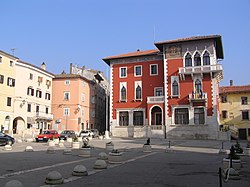Vodnjan
| Vodnjan - Dignano | ||
|---|---|---|
| City | ||
| City of Vodnjan Grad Vodnjan - Città di Dignano |
||

Vodnjan People's Square
|
||
|
||
| Location of Vodnjan within Croatia | ||
| Coordinates: 44°58′N 13°51′E / 44.967°N 13.850°ECoordinates: 44°58′N 13°51′E / 44.967°N 13.850°E | ||
| Country |
|
|
| County |
|
|
| Government | ||
| • Mayor | Klaudio Vitasović (IDS) | |
| Area | ||
| • Total | 100 km2 (40 sq mi) | |
| Elevation | 135 m (443 ft) | |
| Population (2011) | ||
| • Total | 6,119 | |
| • Density | 61/km2 (160/sq mi) | |
| Time zone | CET (UTC+1) | |
| • Summer (DST) | CEST (UTC+2) | |
| Postal code | 52215 | |
| Area code(s) | 052 | |
| Website | vodnjan.hr | |
Vodnjan (pronounced [ʋɔ̌dɲan] (Croat.) or Dignano (ital.) is a town and municipality in Istria County, Croatia.
According to the 2011 census, there are 3,613 inhabitants in Vodnjan-Dignano with total municipality population of 6,119. Municipality of Vodnjan-Dignano had one of the most diverse ethnic structures, with 3,160 Croats (51.64%), 1,017 Italians (16.62%), 425 Bosniaks (6.95%), 299 Roma (4.89%), 242 Serbs (3.95%) and 96 Montenegrins (1.57%) of total population. Montenegrins formed majority in Peroj village. 69.2% are Catholics, 14.0% are Muslims and 6.0% are Orthodox Christians. Many old native residents speak an Istriot language they call Bumbaro. These inhabitants are also called Bumbari.
According to the legend, it developed out of the association of seven villas which were part of the colonial goods of Pula-Pola. Dignano was known as early as Roman times as Vicus Attinianum and listed in historical records in 932 at the time of Pietro Candiniano, to whom the Istrian towns were giving amphorae of good wine in exchange of protection. Inside the historic nucleus, the town preserved its characteristic Medieval look with atria and narrow streets, irregularly winding among houses, with cobble roads and façades made of cobble stone, old streets still impressively recognizable by their Gothic, Venetian Renaissance and Baroque style and many churches rich with memories and art. Among many, in the old town there is St. Jacob Church or delle Trisiere that was designated as a parochial church as early as 1212, a church that witnessed some important historical events such as the peace agreement with Pula-Pola in 1331 and the writing of the Statute of 1492.
The large People Square in the centre of the town denotes the old place where a castle with towers was built probably in the 4th or the 5th century and torn down in 1808. The square is surrounded by important buildings such as the City Hall in the neo-Gothic style, the Benussi house, the Bembo house and the Bradamante palace with its decorated façade and an elegant triphora.
...
Wikipedia


